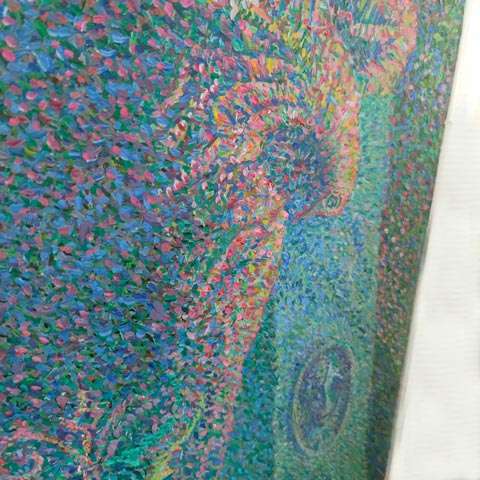
MASTERPIECES
SVESHNIKOV Boris Petrovich (1927–1998) A shadow in the cemetery wasteland. 1981. Oil on canvas. 55 × 95
Romantic title. A funereal theme. The most valuable period. Soft divisionism of the 1980s. Definitely museum-level Sveshnikov.
Regular viewers of our channel know that Sveshnikov's “grave” stories are a complex dispute with fate, a form of the “vanitas” genre — a reflection on the meaning, purpose and frailty of life. He knew what he was talking about, because more than once he was on the verge of life and death. As a teenager, Sveshnikov died several times from starvation and illness in the Gulag, where he was sent for a contrived attempt on Stalin's life. He survived by a miracle. Thanks to his youth and the help of kind people. After his release, Sveshnikov led a quiet life. He worked at Goslitizdat, illustrated fairy tales and poetry by European authors. His works were rarely exhibited at institutes, but more at friends' apartments. Sveshnikov did not participate in high-profile “political” exhibitions (although he was invited to Belyaevo). Nevertheless, he is part of the pantheon of major figures of unofficial postwar art.
1960s UNOFFICIAL ART
BELENOK Petr Ivanovich (1938–1991) Sinbad. 1988. Oil on hardboard. 122 × 122
Note the museum size. A prime example of catastrophism — “panic realism”. A song about a man engaged in an unequal battle with the dangerous unknown. Belenok has lived a difficult life. He exchanged satiety at the cost of opportunism for a half-starved life in Moscow. But this was a life where he did not have to “conform” to the objectives of socialist realism, to produce faceless exhibition material. Belenok did not live to be recognized. He died during perestroika, before the time when collectors would fight for his paintings. Over the past two years we've seen a surge of interest in Belenok's work. And this is no coincidence. Belenok is considered a foreboding artist, a poet of oppressive social atmosphere. And today his work again looks topical and prophetic.
VULOKH Igor Alexandrovich (1938–2012) Landscape — evening. 1989. Cloth, cardboard, oil. 50 × 79.5
In 1961, this subtle and precise artist was expelled from the institute for professional unsuitability. They looked for a harsher wording for Vulokh in order to punish him for the exhibition in Tarusa that was not coordinated “above”. Today collectors fight for his works. They are not only in the main museums of the country, but also in the famous collections — the Semenikhins, Alshibai, Kurtzer and others.
YAKOVLEV Vladimir Igorevich (1934–1998) Flowers and fruits. 1980s. Black pencil on paper. 61 × 43
A large signature drawing, stylistically related to Yakovlev's hospital graphics. This is roughly the kind of work he used to do in nursing homes and mental hospitals. But usually they are small and “sketchy”. And our drawing differs advantageously in size, completeness, elaboration and mood. Valery Silaev notes in his expert report that Yakovlev made similar works as a gift for those who visited him in hospitals.
BORISOV Leonid Konstantinovich (1943–2013) Geometric composition. 1982. Canvas, enamel. 64 × 49
Leonid Borisov is an independent artist of the St. Petersburg “gazanevsky” culture. His first big exhibition was a historic show of independent artists at the Nevsky Cultural Center in September 1975. There were Leonov, Zharkikh, Rukhin — 88 artists in total.
Note the year. Most of Borisov's abstractions that we have encountered on the auction market are from the 1990s–2000s. And here is 1982. Still the USSR. The year of the death of Brezhnev. The highest quality, valuable period — a good opportunity to strengthen the collection.
KOSHELOKHOV Boris (Bob) Nikolaevich (1942–2021) Yellow beast. 2006. Oil on canvas. 70 × 50
A legend of St. Petersburg nonconformism. Whose life was taken by the coronavirus. At the end of the 1970s, Koshelokhov founded the association “Chronicle” (which also included Timur Novikov) and was the ideologist of the Association of Experimental Fine Art. In particular, this work is reproduced in the book “Boris Koshelokhov. Chronicle”.
PANKIN Alexander Fedorovich (1938–2020) The figure of a saint. 1991. Oil on canvas. 106 × 70
Pankin himself called his direction a meta-abstraction — an abstraction about the abstract. In the 1970s, he was the chief architect of the town of Yegoryevsk. And then he met Bielutin, became his student, and began attending classes at the New Reality studio. This is how his path in art began. A few years later, Pankin made a name for himself as a distinctive “artist-mathematician”. His paintings and graphics were exhibited in the hall on Kashirka and others. In 2019 a large retrospective exhibition of Pankin was held at the Museum of Modern Art on Petrovka 25.
- Log in to post comments










